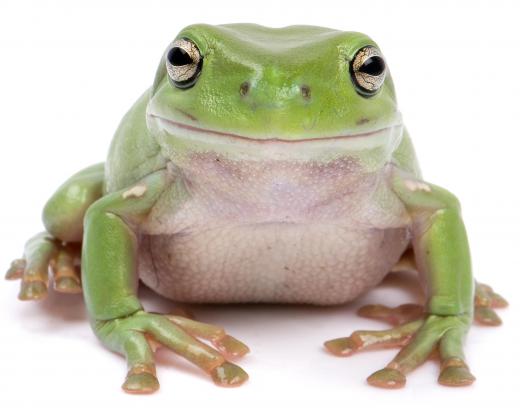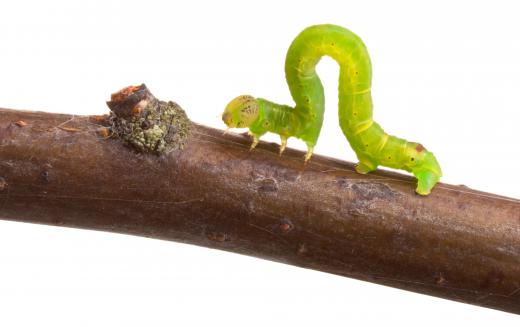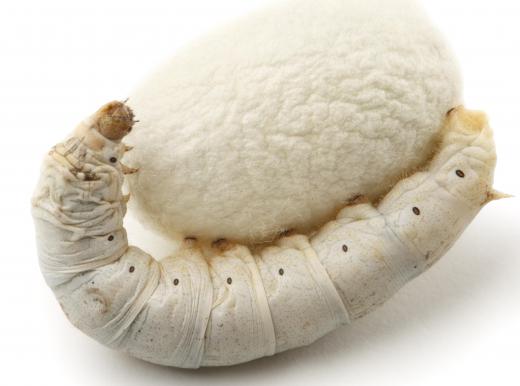What is Metamorphosis?
 Michael Anissimov
Michael Anissimov
Metamorphosis is a process used by certain arthropods, amphibians, mollusks, cnidarians, echinoderms, and tunicates to develop from a juvenile, larval stage into an adult stage. The larva may resemble miniature versions of the adult, or look entirely different, but in most cases have fundamentally different physiology, including special organs.
One of the most popular conceptions of metamorphosis is the transformation of a caterpillar into a butterfly. This has long been seen culturally as a metaphor for transformation and rebirth, the emergence of a beautiful butterfly from an ugly caterpillar. Before engaging in metamorphosis, the caterpillar wraps itself in a sheath known as a cocoon. Cocoons may have commercial value -- the cocoons of silkworms, for instance, are used to make silk. No accurate reproduction of silk has yet been created in the lab.

Metamorphosis can permanently change the organism's capabilities. For instance, tadpoles, the larval form of amphibians, are purely aquatic, but once they metamorphisize, they turn into salamanders, newts, frogs, or toads, and gain the ability to travel on land. Toads, a type of frog adapted to prevent itself from drying out, can even spend hours on land without exposure to water, and survive just on the moisture from burrowing in dirt.

Sometimes the difference between the larval and adult form is so extreme that the most fundamental of characteristics, such as a notocord (a kind of primitive backbone) is present in the larval stage but not with adults, as in the case of tunicates. It is thought that vertebrates may have in fact evolved from the larval form of stationary animals such as tunicates. In a display of a phenomenon known as neotony, all vertebrates may be fancy versions of long-living tunicate larva.

Insects all undergo metamorphosis. There are two main types: incomplete metamorphosis and complete metamorphosis. In the case of incomplete metamorphosis, each instar (exoskeleton shedding stage) only changes slightly from the last, and the organism never enters into a sealed cocoon, also known as a pupa. In complete metamorphosis, the entire insect encloses itself in a pupa, and changes its bodily form considerably. One example would be a maggot transforming itself into a fly. There are many other examples of metamorphosis, in several very large animal phyla. The phenomenon of metamorphosis was apparently lost after amphibians, instead being replaced with further growth inside the womb.
AS FEATURED ON:
AS FEATURED ON:













Discussion Comments
Dragonflies are a great example of an insect that goes through an incomplete metamorphosis. The dragonfly lays its eggs in or near the water and then when the eggs hatch you can see the larval nymph form of the dragonfly.
This larval nymph form is actually pretty interesting because during this stage dragonflies actually have gills so they can breath in the water and hunt for food.
When the dragonfly is ready to shed its larval nymph form it ends up crawling out of the water and will usually rest on some plants. The skin of the larval nymph form breaks open and you finally get to see an adult dragonfly.
This whole process is pretty amazing to watch and you can find lots of free videos online if you want to see it for yourself.
I remember our elementary science classes talking a lot about metamorphosis. We spent a lot of time labeling the life cycles of things like butterflies and frogs. We also ended up watching a few documentaries on the subject.
Our grade five science teacher actually had us raise tadpoles in an aquarium so that we could really see what was happening to the animals. I remember keeping a little journal about the changes we were seeing in our new class pets. It was a really long ongoing project because it took our frog eggs about 14 weeks to become actual frogs. Some stages went much quicker than others if I recall correctly.
@pastanaga - An even easier way to teach your kids about metamorphosis is by planting a butterfly garden. You'll be able to see all the stages of the lifecycle then, including the eggs, larvae, cocoon and the adult.
My favorite is the swan plant, because it attracts Monarch butterflies and they are absolutely gorgeous and easy to spot.
The only thing to consider is that you might get overwhelmed by caterpillars, so try to keep some spare plants on hand so they don't starve themselves when they run out of food.
Keeping tadpoles for your kids is a great way to let them see metamorphosis in action. We used to fish them out of a river near our house and keep them in an old fish tank.
Mom made us keep it outside, because it smelled quite a lot, but I think she was almost as fascinated as we were. Once the frogs had lost their tails, she made us take them back to the river, so that they could continue the cycle though.
I thought that was really mean of her at the time, but now I think it is kind of cool.
Note, that "Metamorphososis" is also a great short story by German writer Franz Kafka, where young Gregor Samsa realizes one morning he has turned into a bug.
Post your comments